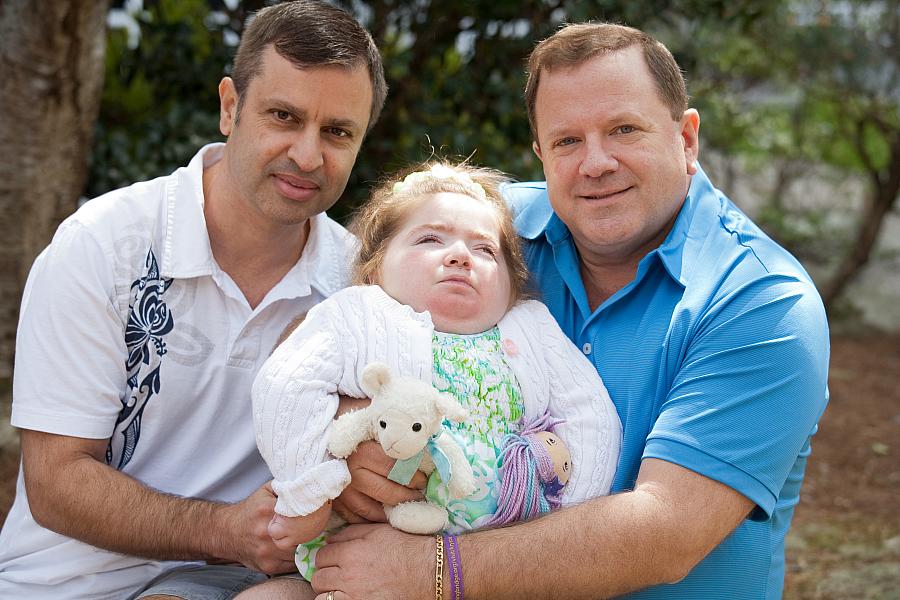Dads turn heartbreak into unrelenting focus on a cure for Tay-Sachs

Bruce Steiger, left, and Rick Karl, with their late daughter Krystie. (Photo courtesy Bruce Steiger)
One of the stories from my days at the Los Angeles Times that haunts me still is a story about Krystie Karl-Steiger. She was a sweet-faced little girl born with the fatal genetic illness Tay-Sachs in 2006. The disease stops a child’s growth at the toddler stage, severely limits movement and robs a child of the ability to communicate.
Krystie ended up with the disease in part because of a lack of thorough genetic screening during an egg donation and surrogate pregnancy. One of her two dads carried the genetic mutation that causes Tay-Sachs and — in an unlucky turn of the genetic wheel — so did the egg donor.
Krystie lived longer than doctors predicted, and her dads, Bruce and Rick, took her everywhere to show her as full a life as she could experience. She died at age 9 in 2015.
Her dads’ dedication to Krystie was the first thing I admired about them. The second thing was how quickly they started to agitate for change. The reason they contacted the Times in the first place was because they wanted to push for changes in the egg and sperm donation industry. After the story was published, the Society for Assisted Reproductive Technology, a fertility industry organization, launched an effort to record the histories of donors and surrogate mothers to prevent genetic diseases like Tay-Sachs from being passed on.
When Krystie was just turning 1, Rick and Bruce helped found and fund the Cure Tay-Sachs Foundation in 2007 with a group of other parents, with the goal of raising money for research into a cure. Rick had a very successful career in operations for companies such as Clorox and Informatica. He was working as a consultant when he decided late in 2016 to make a big shift. He would focus all of his energies on finding a cure for Tay-Sachs.
He took the role of president of the Cure Tay-Sachs Foundation this month.
“I wanted to honor Krystie’s memory,” Rick told me. “Tay-Sachs and several diseases just like it are always fatal to kids. What we have seen as there are many, many kids out there with these diseases, but just not enough of them to rise to the level where a drug company would want to focus on a cure.”
Regular readers of the Center for Health Journalism site will recognize this story. It’s very similar to what we have seen with valley fever, a fungal disease that infects thousands every year and causes horrible complications. Because it mostly occurs in the Southwest and doesn’t have global market potential, valley fever falls into that same “orphan” category that does not typically capture the interest of large drug companies with investors impatient for a profit.
In part because of help from volunteers like Rick and Bruce, the Cure Tay-Sachs Foundation is now the world’s largest funding organization for Tay-Sachs research.
“The research is so very promising, but also pretty damn expensive,” Rick wrote recently in a Facebook post.
That’s why every year around Krystie’s birthday, Jan. 26, Rick works to raise money in her name. She would be 11 this week.
“Krystie and I shared the same birthday, so the day is so bittersweet,” Rick wrote. “Working to raise money for future Tay-Sachs kids is the best way I know to honor my little sweetheart.”
Rick and Bruce remind me a lot of Bob Pack, who I have written about in the past. These parents have had something happen to them that is unfathomable to most of us. They lost their children. In Pack’s case, it was to a preventable accident. In the case of Rick and Bruce, to a disease that can be prevented through better genetic testing and that, one day, may be cured.
It puts one’s own petty problems in perspective to see what these parents are doing to save more children from suffering the same fate.
**

